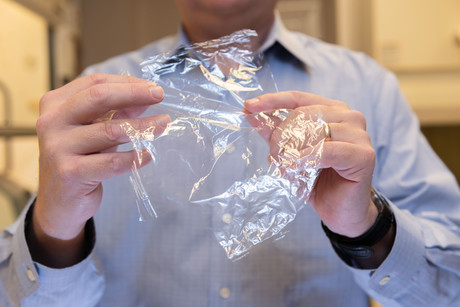Crabs and trees help replace plastic packaging

Material from crab shells and tree fibres could replace the flexible plastic packaging used to keep food fresh, according to researchers at Georgia Institute of Technology.
Consumers are increasingly conscious about the environment, and the food industry is under pressure to use more environmentally friendly packaging. Researchers have developed a sustainable packaging wrap by spraying multiple, alternating layers of chitin nanofibres — found in shellfish, insects and fungi — and cellulose nanocrystals, a common natural biopolymer found in wood pulp.
The film was created by suspending cellulose and chitin nanofibres in water, spraying them onto a surface in alternating layers and waiting for them to dry. This produced a flexible, strong, transparent and compostable material similar to plastic packaging film.
The researchers said they did not set out to create food packaging, but were looking into chitin for another reason when they considered its potential.
“We had been looking at cellulose nanocrystals for several years and exploring ways to improve those for use in lightweight composites as well as food packaging, because of the huge market opportunity for renewable and compostable packaging, and how important food packaging overall is going to be as the population continues to grow,” said J Carson Meredith, a professor in Georgia Tech’s School of Chemical and Biomolecular Engineering. “We recognised that because the chitin nanofibres are positively charged, and the cellulose nanocrystals are negatively charged, they might work well as alternating layers in coatings because they would form a nice interface between them.”
Meredith said they compared the film to PET, or polyethylene terephthalate, which is commonly used in transparent packaging such as soft drink bottles. “Our material showed up to a 67% reduction in oxygen permeability over some forms of PET, which means it could in theory keep foods fresher longer.”
In order to preserve food, packaging must prevent oxygen from passing through. In this sense, the film actually improved on conventional plastic packaging due to its crystalline structure.
“It’s difficult for a gas molecule to penetrate a solid crystal, because it has to disrupt the crystal structure,” Meredith explained. “Something like PET on the other hand has a significant amount of amorphous or non-crystalline content, so there are more paths easier for a small gas molecule to find its way through.”
There is plenty of cellulose and chitin-rich by-products left over from the shellfish food industry, meaning the new films could be a viable alternative to petroleum-based materials in the future. However, the next steps would be to develop a manufacturing process that maximises economy of scale and conducting more research to improve the material’s ability to block water vapour.
The research was published in the journal ACS Sustainable Chemistry and Engineering.
Digital labelling trial proposal in NZ for certain imported food
The New Zealand Minister for Food Safety is seeking feedback on a proposal to enable a trial of...
CCEP's reverse vending machine rollout
Coca-Cola Europacific Partners' first RVM has opened in Moorabbin, with others planned across...
Smarter 'natural' packaging for food of the future
From food waste sugars into natural plastic films, researchers at Monash University are creating...











